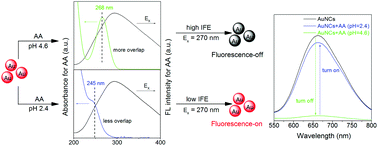Simple fluorescence sensing of extreme acidity based on inner filter effect of ascorbic acid to fluorescent Au nanoclusters†
Abstract
As acidic pH plays essential roles in several organelles, development of pH sensors for extreme acidity is of vital importance. Herein, on the basis of the inner filter effect (IFE) between ascorbic acid (AA) and Au nano-clusters (AuNCs), a simple extreme acidity fluorescence sensor was developed without complex organic synthesis. The as-prepared probe can be used to detect acidity within the pH range of 2.4–4.6. Moreover, the probe possesses high selectivity, good photostability, and excellent reversibility for monitoring extreme acidity in bacterial cells without the influence of autofluorescence.



 Please wait while we load your content...
Please wait while we load your content...